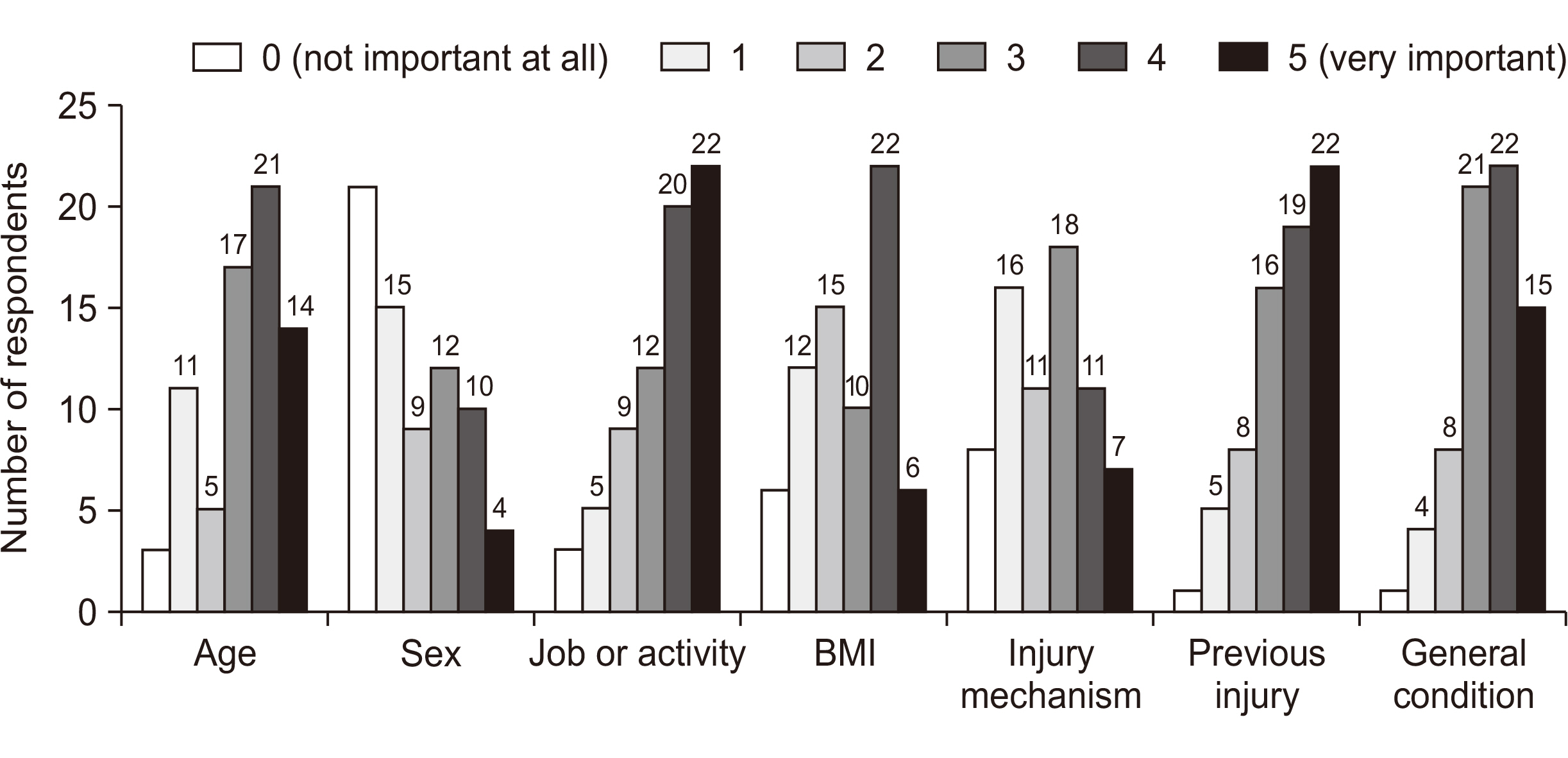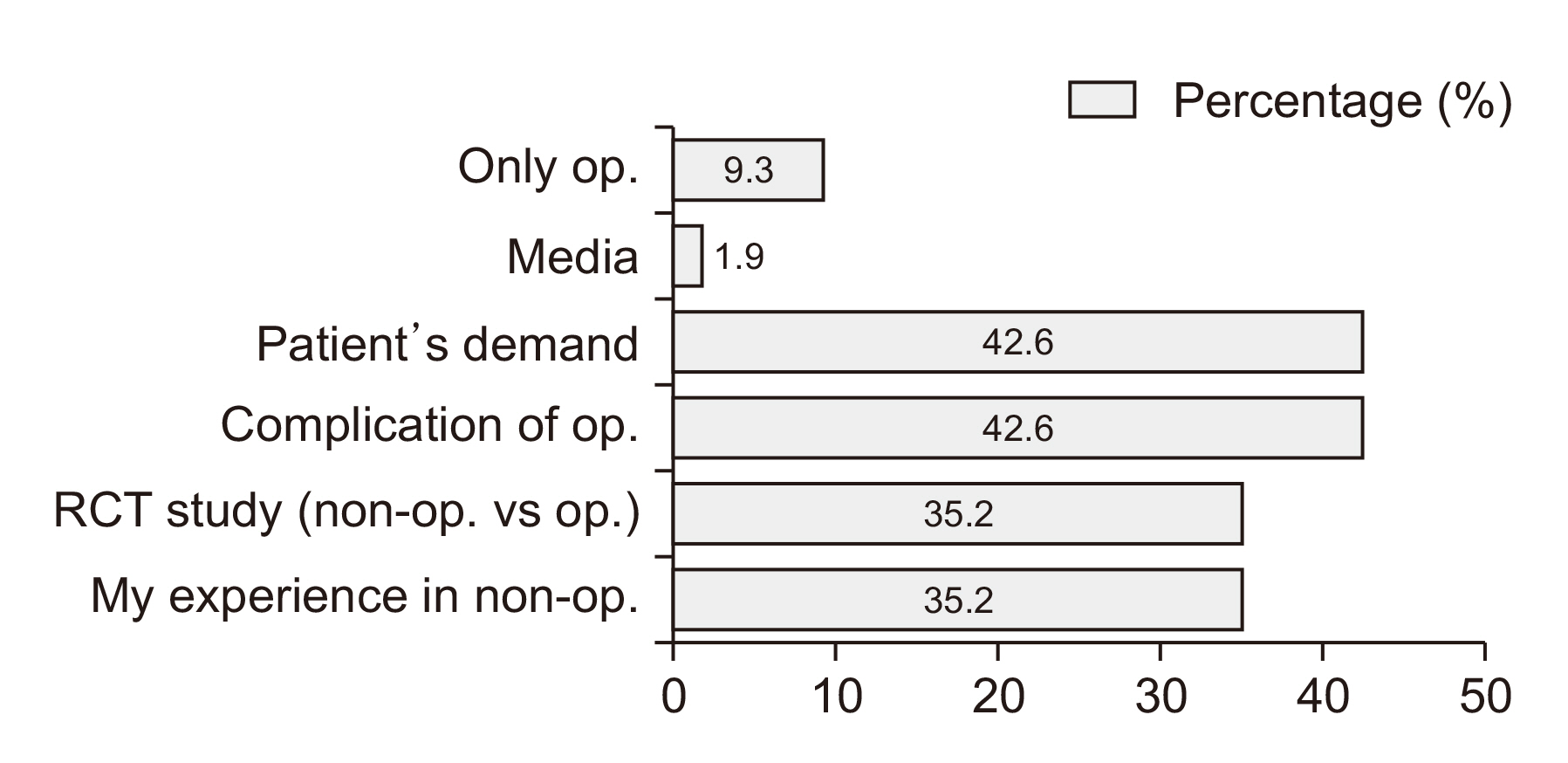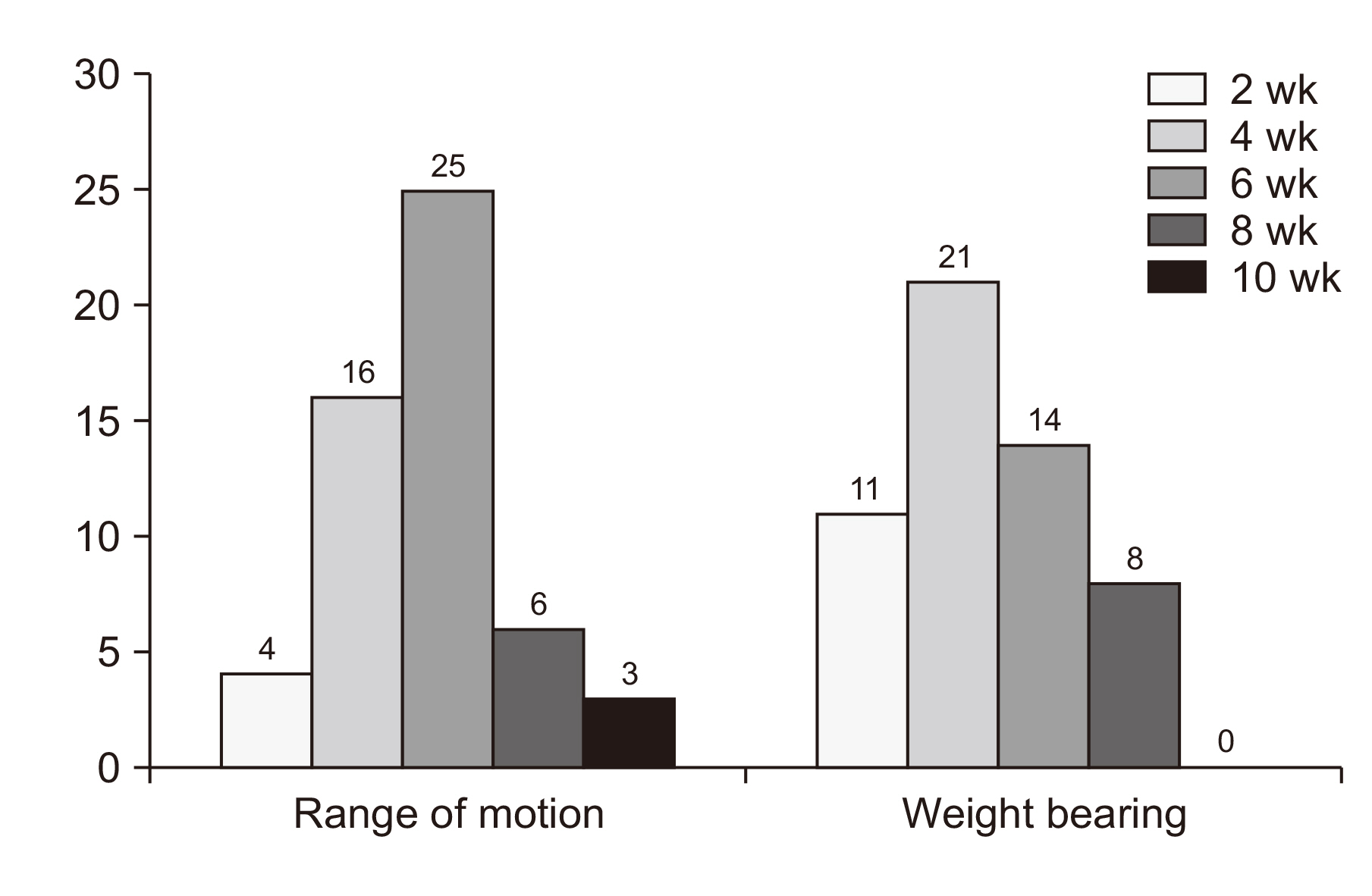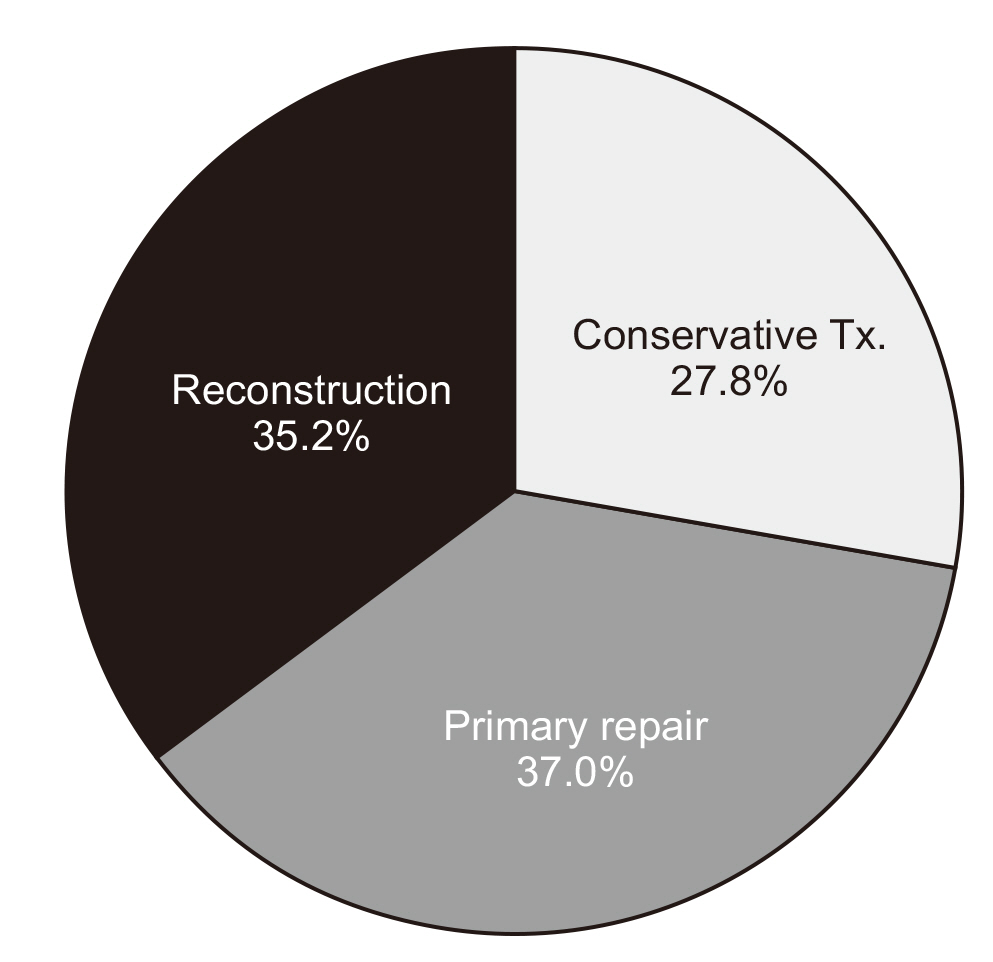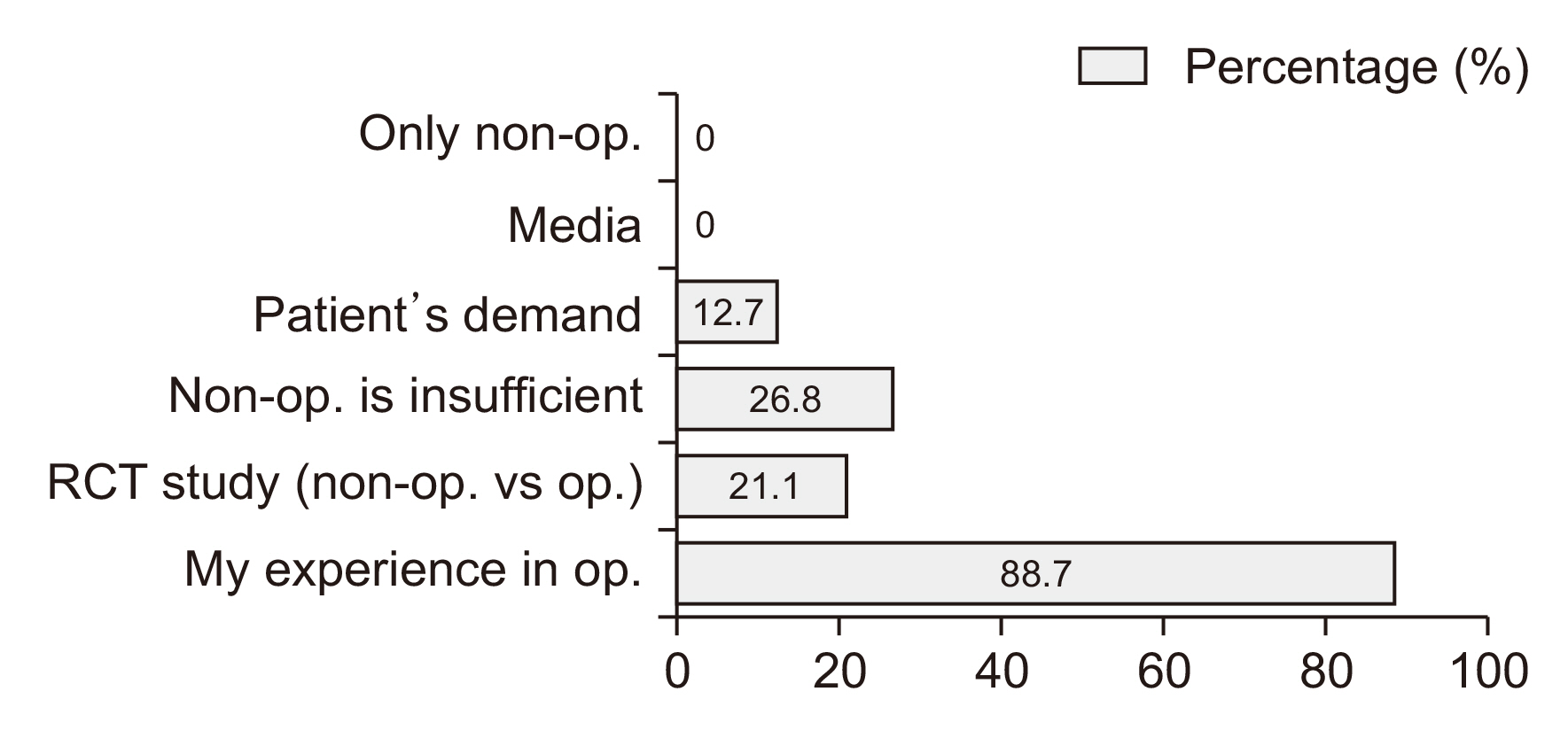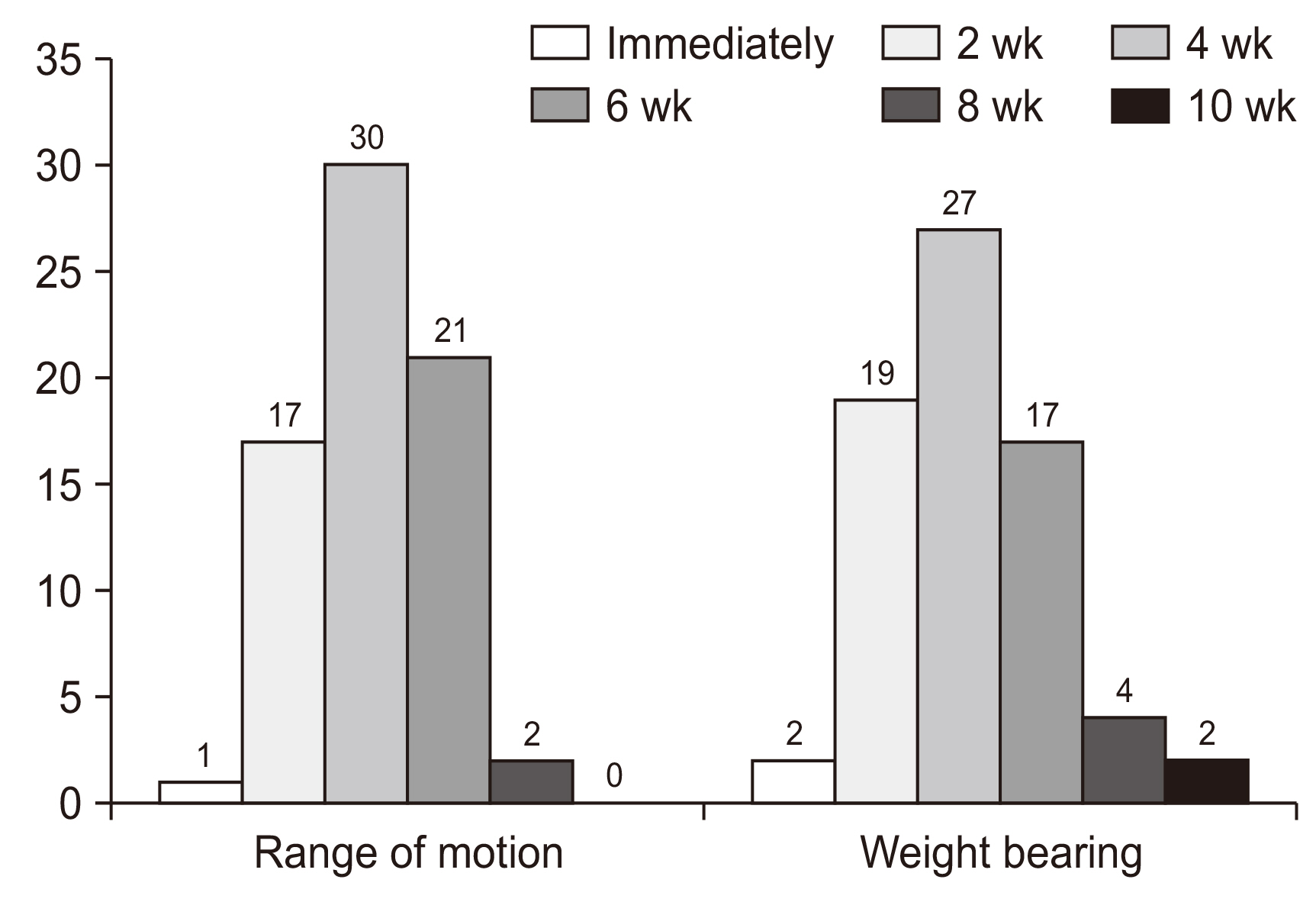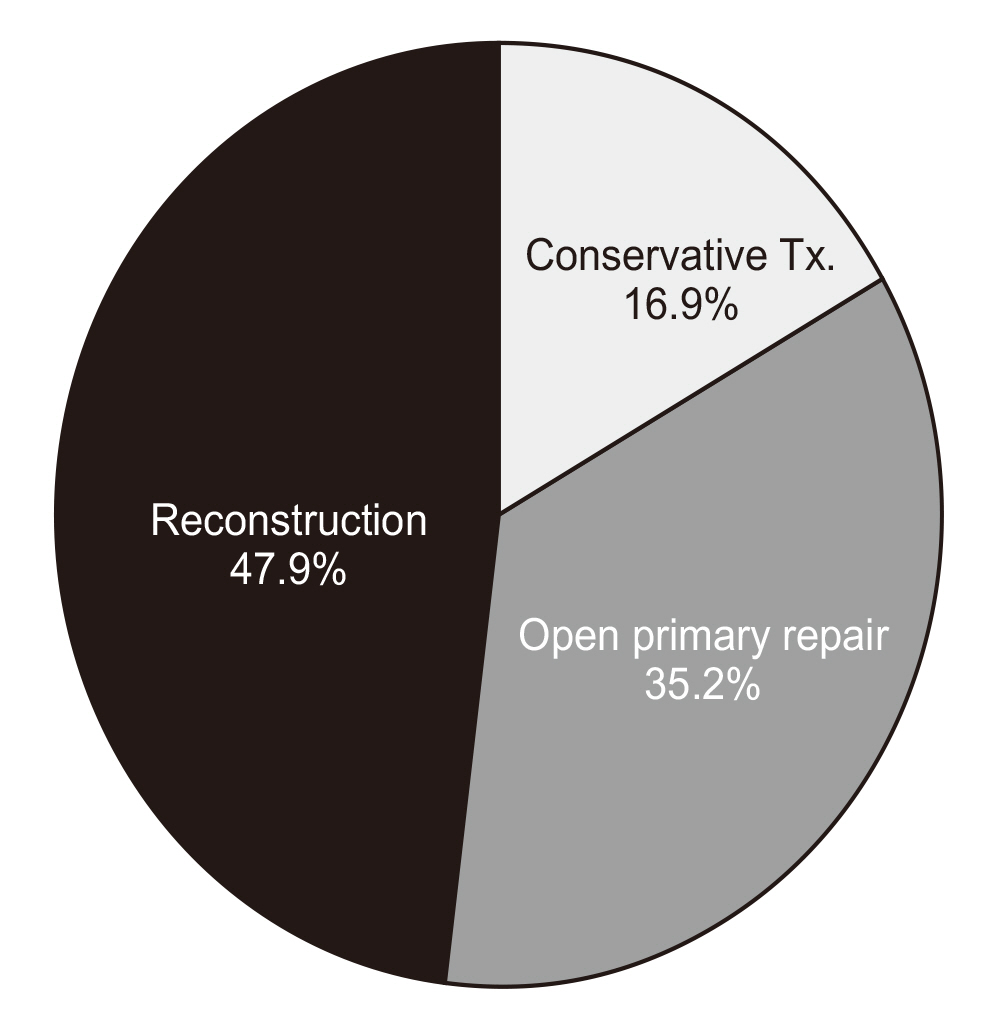J Korean Foot Ankle Soc.
2022 Jun;26(2):88-94. 10.14193/jkfas.2022.26.2.88.
Current Trends in the Treatment of Acute Achilles Tendon Rupture: Analysis of the Korean Foot and Ankle Society (KFAS) Member Survey
- Affiliations
-
- 1Department of Orthopedic Surgery, Hallym University Chuncheon Sacred Heart Hospital, Chuncheon, Korea
- 2Department of Orthopedic Surgery, Chungbuk National University Hospital, Cheongju, Korea
- 3Department of Orthopedic Surgery, Inje University Sanggye Paik Hospital, Seoul, Korea
- KMID: 2530489
- DOI: http://doi.org/10.14193/jkfas.2022.26.2.88
Abstract
- Purpose
This study was based on the Korean Foot and Ankle Society (KFAS) member survey and aimed to report the current trends in the epidemiology, diagnosis, and management of acute Achilles tendon rupture (AATR) over the past few decades.
Materials and Methods
A web-based questionnaire containing 34 questions was sent to all KFAS members in October 2021. The questions were mainly related to the clinical experience and preferred management of patients with AATR. Answers with a prevalence ≥50% of the respondents were considered a tendency.
Results
Seventy-one (12.9%) of the 550 members responded to the survey. The male sex ratio in AATR was answered mean 78%, and the most common age groups were 30~40 years (n=49; 69.0%), and 40~50 years (n=37; 52.1%), in that order. The most common seasons for the occurrence of AATR were spring (37 cases; 52.1%) and autumn (27 cases; 38.0%). Also, sports-related rupture had an average occurrence of 76.2%. The most important clinical factor to determine the type of treatment was the history of previous injuries, and 75.9% of respondents started conservative treatment in the 2010s. The most preferred protocol of conservative treatment was an orthosis capable of ankle range of motion after casting (68.5%), and 53.7% ‘satisfied’ and 1.9% ‘very satisfied’ with conservative treatment. The most preferred surgical method was open repair (80.3%), and the Krackow method (60.6%), and 49.3% of treated patients responded ‘satisfied’ and 45.1% ‘very satisfied’ with this treatment.
Conclusion
This study gives updated information concerning the current trend of epidemiology, diagnosis, and treatment of AATR in Korea. Both consensus and variation in the approach to AATR were identified using this survey study. This study may raise the awareness of various possible approaches toward AATR and should be used to further establish a standard protocol for the management of this injury.
Keyword
Figure
Reference
-
1. Ganestam A, Kallemose T, Troelsen A, Barfod KW. 2016; Increasing incidence of acute Achilles tendon rupture and a noticeable decline in surgical treatment from 1994 to 2013. A nationwide registry study of 33,160 patients. Knee Surg Sports Traumatol Arthrosc. 24:3730–7. doi: 10.1007/s00167-015-3544-5. DOI: 10.1007/s00167-015-3544-5. PMID: 25697284.
Article2. Sheth U, Wasserstein D, Jenkinson R, Moineddin R, Kreder H, Jaglal SB. The epidemiology and trends in management of acute Achilles tendon ruptures in Ontario, Canada: a population-based study of 27 607 patients. Bone Joint J. 2017; 99-B:78–86. doi: 10.1302/0301-620X.99B1.BJJ-2016-0434.R1. DOI: 10.1302/0301-620X.99B1.BJJ-2016-0434.R1. PMID: 28053261.3. Vosseller JT, Ellis SJ, Levine DS, Kennedy JG, Elliott AJ, Deland JT, et al. 2013; Achilles tendon rupture in women. Foot Ankle Int. 34:49–53. doi: 10.1177/1071100712460223. DOI: 10.1177/1071100712460223. PMID: 23386761.
Article4. Saarensilta IA, Edman G, Ackermann PW. 2020; Achilles tendon ruptures during summer show the lowest incidence, but exhibit an increased risk of re-rupture. Knee Surg Sports Traumatol Arthrosc. 28:3978–86. doi: 10.1007/s00167-020-05982-x. DOI: 10.1007/s00167-020-05982-x. PMID: 32313989. PMCID: PMC7669799.
Article5. Guss D, Smith JT, Chiodo CP. 2015; Acute Achilles tendon rupture: a critical analysis review. JBJS Rev. 3:e2. doi: 10.2106/JBJS.RVW.N.00015. DOI: 10.2106/JBJS.RVW.N.00015. PMID: 27490254.6. Uquillas CA, Guss MS, Ryan DJ, Jazrawi LM, Strauss EJ. 2015; Everything Achilles: knowledge update and current concepts in management: AAOS exhibit selection. J Bone Joint Surg Am. 97:1187–95. doi: 10.2106/JBJS.O.00002. DOI: 10.2106/JBJS.O.00002. PMID: 26178893.7. Bergkvist D, Åström I, Josefsson PO, Dahlberg LE. 2012; Acute Achilles tendon rupture: a questionnaire follow-up of 487 patients. J Bone Joint Surg Am. 94:1229–33. doi: 10.2106/JBJS.J.01601. DOI: 10.2106/JBJS.J.01601. PMID: 22760392.8. Soroceanu A, Sidhwa F, Aarabi S, Kaufman A, Glazebrook M. 2012; Surgical versus nonsurgical treatment of acute Achilles tendon rupture: a meta-analysis of randomized trials. J Bone Joint Surg Am. 94:2136–43. doi: 10.2106/JBJS.K.00917. DOI: 10.2106/JBJS.K.00917. PMID: 23224384. PMCID: PMC3509775.9. Khan RJ, Fick D, Keogh A, Crawford J, Brammar T, Parker M. 2005; Treatment of acute achilles tendon ruptures. J Bone Joint Surg Am. 87:2202–10. doi: 10.2106/JBJS.D.03049. DOI: 10.2106/JBJS.D.03049. PMID: 16203884.
Article10. Nilsson-Helander K, Silbernagel KG, Thomeé R, Faxén E, Olsson N, Eriksson BI, et al. 2010; Acute achilles tendon rupture: a randomized, controlled study comparing surgical and nonsurgical treatments using validated outcome measures. Am J Sports Med. 38:2186–93. doi: 10.1177/0363546510376052. DOI: 10.1177/0363546510376052. PMID: 20802094.11. Pajala A, Kangas J, Siira P, Ohtonen P, Leppilahti J. 2009; Augmented compared with nonaugmented surgical repair of a fresh total Achilles tendon rupture. A prospective randomized study. J Bone Joint Surg Am. 91:1092–100. doi: 10.2106/JBJS.G.01089. DOI: 10.2106/JBJS.G.01089. PMID: 19411457.12. Ochen Y, Beks RB, van Heijl M, Hietbrink F, Leenen LPH, van der Velde D, et al. 2019; Operative treatment versus nonoperative treatment of Achilles tendon ruptures: systematic review and meta-analysis. BMJ. 364:k5120. doi: 10.1136/bmj.k5120. DOI: 10.1136/bmj.k5120. PMID: 30617123. PMCID: PMC6322065.
Article13. Wilkins R, Bisson LJ. 2012; Operative versus nonoperative management of acute Achilles tendon ruptures: a quantitative systematic review of randomized controlled trials. Am J Sports Med. 40:2154–60. doi: 10.1177/0363546512453293. DOI: 10.1177/0363546512453293. PMID: 22802271.
Article14. Gatz M, Driessen A, Eschweiler J, Tingart M, Migliorini F. 2021; Open versus minimally-invasive surgery for Achilles tendon rupture: a meta-analysis study. Arch Orthop Trauma Surg. 141:383–401. doi: 10.1007/s00402-020-03437-z. DOI: 10.1007/s00402-020-03437-z. PMID: 32266518.
Article15. Movin T, Ryberg A, McBride DJ, Maffulli N. 2005; Acute rupture of the Achilles tendon. Foot Ankle Clin. 10:331–56. doi: 10.1016/j.fcl.2005.01.003. DOI: 10.1016/j.fcl.2005.01.003. PMID: 15922923.
Article16. Maffulli N, Waterston SW, Squair J, Reaper J, Douglas AS. 1999; Changing incidence of Achilles tendon rupture in Scotland: a 15-year study. Clin J Sport Med. 9:157–60. doi: 10.1097/00042752-199907000-00007. DOI: 10.1097/00042752-199907000-00007. PMID: 10512344.17. Park HG, Youn D, Baik JM, Hwang JH. 2021; Epidemiology of Achilles tendon rupture in South Korea: claims data of the National Health Insurance Service from 2009 to 2017. Clin Orthop Surg. 13:539–48. doi: 10.4055/cios20255. DOI: 10.4055/cios20255. PMID: 34868504. PMCID: PMC8609222.
Article18. Willits K, Amendola A, Bryant D, Mohtadi NG, Giffin JR, Fowler P, et al. 2010; Operative versus nonoperative treatment of acute Achilles tendon ruptures: a multicenter randomized trial using accelerated functional rehabilitation. J Bone Joint Surg Am. 92:2767–75. doi: 10.2106/JBJS.I.01401. DOI: 10.2106/JBJS.I.01401. PMID: 21037028.19. Sheth U, Wasserstein D, Jenkinson R, Moineddin R, Kreder H, Jaglal S. Practice patterns in the care of acute Achilles tendon ruptures: is there an association with level I evidence? Bone Joint J. 2017; 99-B:1629–36. doi: 10.1302/0301-620X.99B12.BJJ-2017-0465.R1. DOI: 10.1302/0301-620X.99B12.BJJ-2017-0465.R1. PMID: 29212686.20. Huttunen TT, Kannus P, Rolf C, Felländer-Tsai L, Mattila VM. 2014; Acute achilles tendon ruptures: incidence of injury and surgery in Sweden between 2001 and 2012. Am J Sports Med. 42:2419–23. doi: 10.1177/0363546514540599. DOI: 10.1177/0363546514540599. PMID: 25056989.21. Kearney RS, Parsons N, Underwood M, Costa ML. 2015; Achilles tendon rupture rehabilitation: a mixed methods investigation of current practice among orthopaedic surgeons in the United Kingdom. Bone Joint Res. 4:65–9. doi: 10.1302/2046-3758.44.2000400. DOI: 10.1302/2046-3758.44.2000400. PMID: 25868938. PMCID: PMC4448123.
- Full Text Links
- Actions
-
Cited
- CITED
-
- Close
- Share
- Similar articles
-
- Achilles Tendon Rupture Associated With Ipsilateral Medial Malleolar Fracture (A Case Report)
- Nonoperative Treatment of Acute Achilles Tendon Rupture
- Achilles Tendon Rupture Associated with Ipsilateral Bimalleolar Fracture: A Case Report
- Current Updates in the Treatment of Achilles Tendon Rupture
- Minimal Invasive Surgery for Acute Achilles Tendon Rupture


